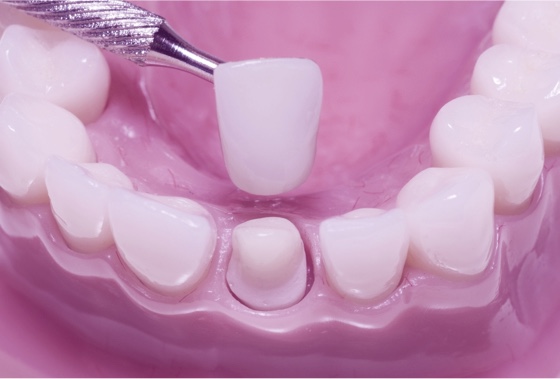A crown is a tooth-shaped “cap” that rebuilds and strengthens a damaged or weakened tooth. Unlike dental fillings that simply patch or fill in a portion of a tooth, a dental crown fully covers the entire visible portion of a tooth that lies above the gum line.
Crowns improve the outer surface and appearance of a tooth, restoring its shape and size and improving its overall strength and appearance. In the case of discolored teeth, dental crowns will hide the discoloration and improve the appearance of your teeth.
Crowns are also used in dental bridgework and are the covering for dental implants.
Greenspoint Dental has a dedicated team offering dental crown services in north Houston, TX. Now, we’re able to offer crowns while you wait.

Types of Dental Crowns
Metal Dental Crowns
These include gold, palladium, chromium, or nickel alloys. Since metal tooth crowns are very durable and are resistant to normal wear and tear, they are mostly used in molars and where grinding and chewing forces are most prevalent. However, the color of these crowns is very visible and they are better placed at the backside of the mouth where there is limited tooth visibility.
Ceramic or Porcelain Dental Crowns
These crowns resemble the natural color of teeth and are primarily used for front teeth. Those with metal allergies are also recommended to use these crowns
Resin Dental Crowns
These crowns are the cheapest and the most indistinguishable from natural teeth among all other crowns. However, they are less durable and prone to chipping.
Porcelain Fused to Metal Dental Crowns
These crowns have the strength of metal crowns and the appearance of ceramic crowns. They are therefore used for structurally damaged and discolored teeth.
There are many advantages to “sleep dentistry”:
- Helps you maintain great oral hygiene since you aren’t afraid to get dental treatments.
- Procedures that may take hours feel like only a few minutes.
- Stay awake during the treatment, but feel so comfortable and peaceful you don’t remember it.
- Sedation dentistry is extremely safe since you are monitored the entire time by skilled dental professionals.
- You can feel relaxed for five to six hours after the sedation, depending on which is used.
- Depending on the sedation, you may not be able to drive yourself home. Make sure you have someone who can take you home, so you can rest until you are fully alert.
- People who have difficulty going numb will not have any issues with sedation dentistry.We at Greenspoint Dental in Houston, offer different kinds of sedation dentistry, depending on your dental needs. Give us a call at (281) 823-9987.
The crowning procedure formerly required two, separate visits to a dentist two weeks apart. Many dental offices still might, but Greenspoint Dental has acquired a new piece of equipment, allowing us to make crowns in-house, while you wait.
During the appointment, dentists examine your affected tooth, if the crown is coverings a tooth. An x-ray may be taken to check the root status of the tooth. The dentist will then numb (anesthetize) the tooth and its surrounding tissue. The tooth will then be filed down along its sides and chewing surface; the amount of preparation depends on decay present in the tooth as well as the crown material to be used. For example, metal crowns require less filing as they are thinner than porcelain crowns. If a large portion of your tooth is missing, the filling material is instead used to build up the tooth to effectively support the crown. If the crown is being placed into bridgework, the original tooth has already been removed.
A scan is made of your mouth using 3D mapping technology. Formerly, the dentist would make an impression of the teeth below and above the tooth to receive a crown. This way, the dental crown will not affect the normal bite.

With new on-site milling technology, original or replacement crowns can be made while you wait and installed in the same sitting. Additionally, the map of your mouth and the dimensions of your crown are kept with your files, along with x-rays. Should you even break a crown, another can be made easily with the stored digital file.
Formerly, impressions were used to fabricate a dental crown at the laboratory, taking between 2 to 3 weeks. If a patient were to need the lab-produced crown, a temporary dental crown can be placed over your prepared tooth with temporary cement to hold it in place during the waiting period.
If you have further questions about dental crowns or would like to set up a consultation with a member of our staff, call or contact our north Houston dental clinic today.
Schedule an Appointment with us